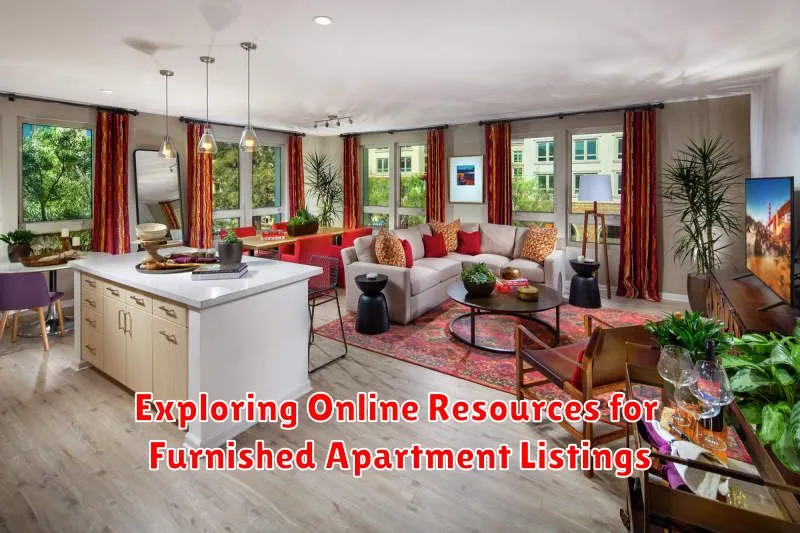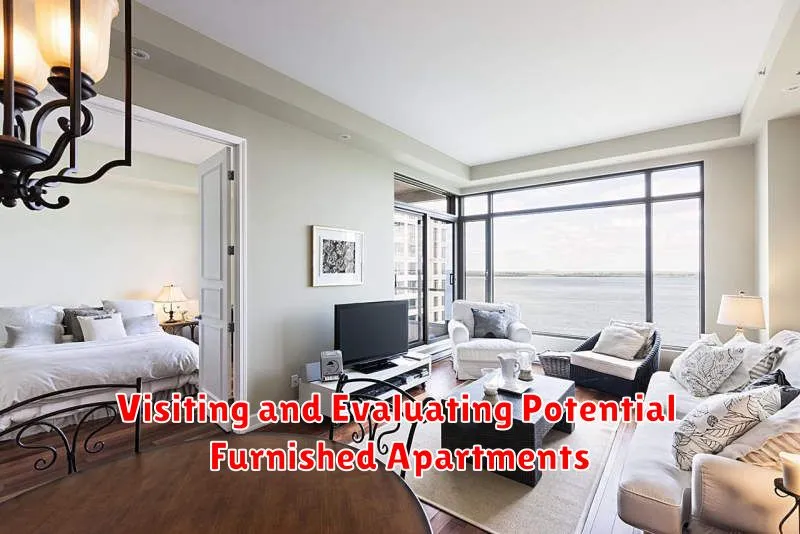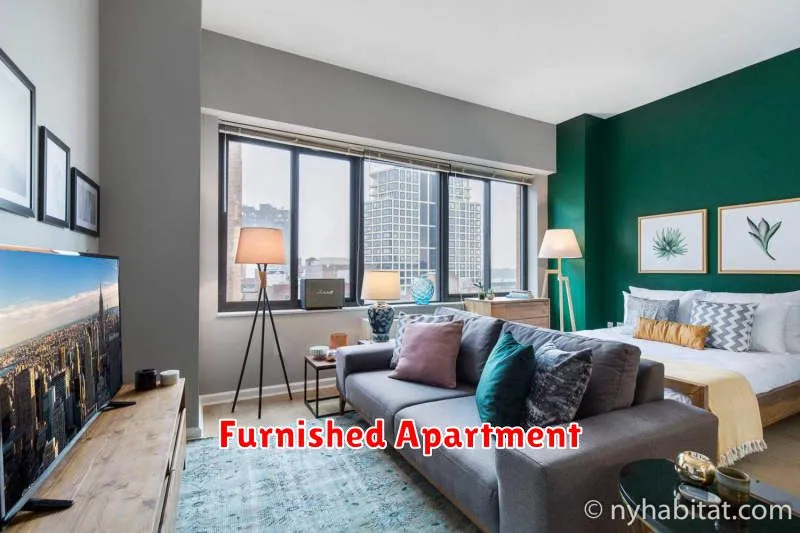Finding a new place to live can be stressful, especially if you’re on a tight deadline or need to move quickly. If you’re looking for a hassle-free move, renting a furnished apartment could be the perfect solution. Furnished apartments come equipped with everything you need, from beds and couches to kitchen appliances and linens, making it easy to settle in right away. Whether you’re a student, a traveling professional, or simply someone who wants to avoid the hassle of moving furniture, this guide will provide you with all the information you need to find the perfect furnished apartment for your needs.
Determining Your Needs and Budget for a Furnished Apartment
Before embarking on your search for a furnished apartment, it’s crucial to define your needs and budget. This will ensure you find a space that aligns with your lifestyle and financial constraints.
Consider the following factors:
Size and Layout:
How much space do you require? Do you need a separate bedroom or is a studio apartment sufficient? What kind of layout works best for your needs?
Amenities:
What amenities are non-negotiable for you? Is access to laundry facilities, a gym, or a pool essential? Make a list of desired amenities to streamline your search.
Location:
Where do you want to live? Consider proximity to your workplace, public transportation, shops, and restaurants. Location plays a significant role in your overall satisfaction.
Budget:
Establish a realistic budget for rent. Remember to factor in additional expenses like utilities, internet, and parking. Consider setting a maximum rent limit to guide your search.
Furnishings:
Determine the level of furnishing you need. Do you require a fully furnished apartment, or are you willing to bring your own furniture for certain areas? Clarify your preferences to avoid disappointment.
By carefully considering these factors, you’ll be able to create a clear picture of your ideal furnished apartment and ensure a smoother search process.
Exploring Online Resources for Furnished Apartment Listings

Finding a furnished apartment can be a great option for those who want to move quickly or don’t want to worry about buying furniture. There are a variety of online resources available that can help you find the perfect furnished apartment for your needs.
One of the most popular options is Craigslist. While it’s known for its variety of listings, it’s important to be cautious and meet in a public place when viewing properties. For greater security, you may want to consider sites like Apartments.com, Zillow, and Trulia, which allow you to filter your search for furnished apartments specifically.
Specialized websites like FurnishedFinder.com and Airbnb cater to the furnished apartment market. They offer a diverse range of properties, from short-term rentals to long-term leases. You can refine your search by location, price, and desired amenities.
Another option is to check out corporate housing providers, which often offer fully furnished apartments for extended stays. These are a great choice for business travelers or those who need temporary housing. Websites like Oakwood.com and Exécutive Residence by Marriott are good starting points.
Don’t underestimate the power of social media. Facebook groups and local forums dedicated to housing can be valuable resources for finding furnished apartments. These groups allow you to connect directly with landlords or individuals who are renting out their furnished spaces.
When using online resources, be sure to read reviews and check the reputation of the website or company. Remember to ask questions about the rental agreement, amenities, and any additional fees associated with the furnished apartment.
Working with a Real Estate Agent Specializing in Furnished Apartments
Working with a real estate agent specializing in furnished apartments can be a huge advantage when you’re searching for a temporary or short-term rental. These agents have a deep understanding of the furnished rental market and can connect you with properties that meet your specific needs and budget. Here are some key benefits of working with a furnished apartment specialist:
Access to a wider inventory: Furnished apartment specialists have access to a wider inventory of properties than you might find on your own. They often have exclusive listings and connections with landlords who specialize in furnished rentals.
Personalized service and expertise: A good agent will take the time to understand your needs and preferences. They can help you narrow down your search criteria, identify suitable neighborhoods, and negotiate the best terms on your lease.
Negotiation and contract assistance: Real estate agents are skilled negotiators and can help you secure the best possible price and terms on your lease. They can also review the lease agreement to ensure it’s fair and protect your interests.
Local market knowledge: Furnished apartment specialists have a strong understanding of the local market, including rental trends, pricing, and neighborhood amenities. They can provide valuable insights to help you make informed decisions.
Time-saving: Searching for a furnished apartment can be time-consuming and overwhelming. Working with an agent frees up your time and allows you to focus on other important tasks.
Directly Contacting Property Management Companies
Reaching out to property management companies directly is a proactive way to find furnished apartments. These companies often manage multiple properties, giving you access to a wider range of options. You can either search online for property management companies in your desired area or utilize resources like the National Apartment Association (NAA) to find local companies. When contacting them, be clear about your needs, including your preferred location, budget, and the requirement for a furnished apartment. Ask about available units and if they offer any special promotions or incentives.
Networking and Utilizing Social Media for Furnished Apartment Leads
Networking and social media can be powerful tools in your search for furnished apartments. Here’s how to leverage them:
Personal Connections: Reach out to friends, family, colleagues, and acquaintances who might live in the area you’re interested in. They may know of available units or be able to provide valuable insights.
Online Communities: Join Facebook groups, forums, and social media communities dedicated to housing, relocation, or the specific city you’re targeting. These groups often feature discussions about furnished rentals and can provide insider tips.
Social Media Advertising: Utilize targeted advertising on platforms like Facebook and Instagram. By specifying your location, desired features, and budget, you can reach potential landlords or property managers who are actively seeking tenants for furnished apartments.
Hashtags: Use relevant hashtags on social media, such as #furnishedapartments, #rentals, #housing, and #apartmentliving, to increase visibility and reach a wider audience.
Content Creation: Consider creating posts on social media seeking leads for furnished rentals. Share your specific needs and desired location to attract potential landlords or renters looking to sublet.
Visiting and Evaluating Potential Furnished Apartments

Once you’ve narrowed down your search to a few promising furnished apartments, it’s time to schedule viewings. This is your chance to get a real feel for the space and assess if it meets your needs. When visiting potential apartments, pay close attention to the following:
Condition of furniture: Is the furniture in good condition? Are the sofas, beds, tables, and other items clean and free from wear and tear?
Functionality: Does the furniture suit your lifestyle and needs? If you’re a student, do you need a desk and chair for studying? If you enjoy cooking, is there adequate kitchen equipment and storage space?
Layout and Size: Is the layout of the apartment practical and does it feel spacious enough for your belongings and daily activities? Make sure the furniture fits comfortably in the space and doesn’t obstruct traffic flow.
Maintenance and Repairs: Look for any signs of damage or disrepair in the apartment, such as cracks in the walls, leaky faucets, or malfunctioning appliances. Ask the landlord about their maintenance policy and how quickly they address issues.
Cleanliness and Overall Impression: Does the apartment feel clean and well-maintained? Is the building secure and quiet? Trust your gut feeling – if something doesn’t feel right, it probably isn’t the right place for you.
Understanding Lease Terms and Conditions for Furnished Rentals
When renting a furnished apartment, it’s crucial to carefully review the lease agreement to understand the terms and conditions. This will ensure you are aware of your responsibilities as a tenant and protect yourself from any unexpected issues.
Here are some key aspects to consider when reading a furnished rental lease:
Inventory List
The lease should include a comprehensive inventory list of all furniture, appliances, and fixtures provided in the apartment. This list serves as a record of the condition of the items at the start of your tenancy. It’s vital to carefully review the list, noting any existing damage or wear and tear. Take photos for documentation purposes.
Maintenance and Repairs
The lease should outline the responsibilities for maintaining the furnished items. Determine who is responsible for repairs, whether the landlord or the tenant. Some leases may have a specific clause regarding damage or wear and tear caused by the tenant, requiring them to pay for repairs beyond normal use.
Rental Period and Termination
The lease will specify the rental period, typically a month-to-month or a fixed-term lease. It will also detail the termination process, including the required notice period for both parties. Make sure you understand the implications of early termination, as it may involve penalties or the requirement to return the furniture in good condition.
Security Deposit
The lease should outline the amount of the security deposit, which is typically refundable at the end of the tenancy. The purpose of the security deposit is to cover any damages to the apartment or its furnishings beyond normal wear and tear. It’s important to understand how the deposit will be handled and under what circumstances deductions will be made.
Other Clauses
The lease may include other clauses related to furnished rentals, such as:
- Restrictions on subletting or assigning the lease
- Policies regarding pets or smoking
- Provisions for accessing the apartment for maintenance and repairs
- Guidelines for disposing of trash and recycling
It’s essential to ask any questions you have and ensure you fully comprehend the lease agreement before signing it. Understanding the terms and conditions will help you avoid potential disputes and ensure a smooth and enjoyable rental experience.
Negotiating Rent and Utilities

Once you’ve found a furnished apartment that meets your needs, you can start negotiating the rent and utilities. This is a common practice, especially in competitive rental markets. Be prepared to present your case and be polite but firm in your requests.
Start by researching the average rent for similar furnished apartments in the area. You can use online resources like Zillow, Trulia, or Apartments.com. Once you have a baseline, you can determine if the listed rent is fair. If it’s significantly higher than the average, you may have more leverage to negotiate.
When negotiating, it’s important to be respectful and understand the landlord’s perspective. Explain why you’re interested in the apartment and highlight any unique qualifications you possess, such as a strong credit history or a long-term lease commitment. Be prepared to offer a counter-offer that’s fair and reasonable for both parties.
In addition to rent, you can also negotiate utilities. Some landlords include utilities in the rent, while others require tenants to pay them separately. If you’re paying separately, you may be able to negotiate a lower rate or a package deal that includes multiple utilities. Make sure to clearly understand the terms of the lease agreement, including the payment schedule and any penalties for late payments.
Ensuring the Condition and Inventory of Furnishing
Before you move in, it’s crucial to thoroughly inspect the furniture and document its condition. Take photos of any pre-existing damage or wear and tear, and create a detailed inventory list. Include the type, brand, and any identifying features of each piece. This documentation will be invaluable if any disputes arise regarding the condition of the furnishings upon your move-out.
It’s also essential to discuss the condition of the furniture with the landlord or property manager. Clarify what repairs or replacements will be handled by them and what you are responsible for. This ensures a clear understanding of your responsibilities and helps prevent potential conflicts in the future.

